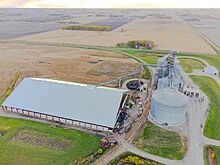
Grain bins are bulk storage structures for dry wheat, soybean, maize, oats, barley and more. Grain bins are cylinders made of corrugated sheets or sheet metal with a coned metal roof that has vents. The floors of grain bins have aeration systems to keep good air flow through the commodities and keep it at a good temperature and humidity level to prevent spoilage. At the top of each grain bin there are tubed conveyors to transport the grain. The grain bin sits on top of a strong concrete base to help the structure withstand high winds and the massive weight from the grain.
Difference between grain bins and silos
Grain bins differ from farm silos which usually store foraged silage for animal feed and are made of concrete. Silos have no ventilation system promoting fermentation of the grain product. Silos typically have a domed roof with no conveyors.
Grain moisture levels
Corn is typically stored around 15% wet basis and soybean around 13%. The cold winter months are ideal for storing crops because of the low humidity levels, temperature, and pest problems. Storing grain in the bins for more than six months into the spring and summer means they will have to be aerated more then to keep the temperature and humidity down.
Grain dryers

(Click for video)
Grain bins typically have grain dryers next to them which heat the grain to lower moisture content before storage within in the bins. Applying too much heat to the grain when attempting to lower moisture content can cause shrinkage which cuts into profits. Some farms have small grain bins and a dryer to lower moisture content before they sell to a larger local commercial grain bin.
Transporting to and from the grain bin

When grain is harvested from a farm with a Combine harvester the combine typically loads the grain into a grain cart, which then unloads it into a grain hopper trailer, gravity wagon, or dump truck to be hauled to the local grain bin. The commercial grain bin operator then sells the commodity at an opportune time and it is then transported, with a grain hopper trailer or dump truck, to a grain elevator to be put on a barge or grain train, if the grain bin isn't already at the grain elevator site.
References
- "What's the Difference Between Grain Bins and Silos?". Ohio, United States: TAM Systems. March 9, 2021. Retrieved October 31, 2023.
- Stiers, Joanie (August 13, 2022). "The Difference Between Grain Bins and Silos". Partners. Illinois Farm Bureau.
- Ileleji, Klein (March 10, 2022). "Grain Quality – It's Time To Check Your Stored Grain". ENTM Extension Newsletters. Purdue University. Retrieved October 31, 2023.
- "Continuous Flow Dryers". Products. GSI. Retrieved October 31, 2023.